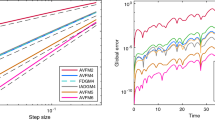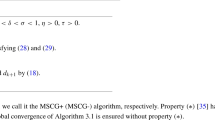Summary
We present the gradient method as a numerical procedure for the discrete spectrum of Hamiltonian operators in a version which is more general and has better numerical flexibility than a previous version. We show that the gradient method, in addition to have relationships to the Rayleigh-Schrödinger perturbation theory and to the variational method, has also some advantageous features in comparison with them and even in comparison with the Padé and Borel summability methods. In order to check the numerical efficiency of our procedure, we have applied it, with encouraging results, to the calculation of the ground-state energy of the anharmonic oscillatorsp 2 +x 2 +βx 4 andp 2 +x 2 +βx 8 for a large range of β.
Riassunto
Si presenta il metodo del gradiente come procedimento numerico per lo spettro discreto di operatori hamiltoniani in una versione che è piú generale ed ha una migliore flessibilità numerica di una precedente versione. Si mostra che il metodo del gradiente, oltre ad avere connessioni con la teoria perturbativa di Rayleigh-Schrödinger e col metodo variazionale, ha anche vantaggi su questi e perfino sui metodi di sommabilità di Padé e Borel. Al fine di provare l’efficienza numerica del procedimento, questo è stato applicato, con risultati incoraggianti, al calcolo dell’energia dello stato fondamentale degli oscillatori anarmonicip 2 +x 2 +βx 4 ep 2 +x 2+βx8 per un largo intervallo di β.
Similar content being viewed by others
References
L. V. Kantorovich andG. P. Akilov:Functional Analysis in Normed Spaces (Oxford, 1964).
M. Z. Nashed:J. Math. Mech.,14, 765 (1964);E. S. Levitin andB. T. Polyak:Ž. Vychisl. Mat. Mat. Fiz.,6, 787 (1966);B. T. Polyak:Ž. Vchyisl. Mat. Mat. Fiz.,9, 4, 807 (1969);H. Tokumaru, N. Adachi andK. Goto:SIAM J. Control,8, 163 (1970);V. M. Safro:USSR Comp. Math. Math. Phys.,2, 212 (1976);B. Pchénitchny andY. Daniline:Méthodes numeriques dans les probléms d'extrémum (Moscou, 1977).
R. McWeeny:Proc. R. Soc. London Ser. A,235, 496 (1957).
S. Polezzo:Theor. Chim. Acta,38, 211 (1975);B. T. Sutcliffe:Theor. Chim. Acta,39, 93 (1975).
M. Di Toro, G. Russo andF. Duggan:Phys. Rev. C,21, 2054 (1980);P. Ring andP. Shuck:The Many-Body Problem (New York, N. Y., 1980);P. G. Reinhard andR. Y. Cusson:Nucl. Phys. A,378, 418 (1982).
G. Fonte: preprint, Catania University.
G. Fonte andG. Schiffrer:Nuovo Cimento B,37, 63 (1977).
G. Fonte:Nuovo Cimento B,49, 200 (1979).
G. Fonte:J. Math. Phys. (N. Y.),21, 800 (1980).
M. Reed andB. Simon:Methods of Modern Mathematical Physics, Vol. IV:Analysis of Operators (New York, N. Y., 1978).
T. Kato:Perturbation Theory of Linear Operators (Berlin, 1966).
C. S. Sharma:Phys. Rep. C,26, 1 (1976).
M. Reed andB. Simon:Methods of Modern Mathematical Physics, Vol. II:Fourier Analysis, Self-adjointness (New York, N. Y., 1975).
F. H. Stillinger:J. Chem. Phys.,45, 3623 (1966);F. H. Stillinger andD. K. Stillinger:Phys. Rev. A,10, 1109 (1974).
J. J. Loeffel, A. Martin, B. Simon andA. Wightman:Phys. Lett. B,30, 656 (1969).
S. Graffi, V. Grecchi andG. Turchetti:Nuovo Cimento B,4, 313 (1971).
S. Graffi, V. Grecchi andB. Simon:Phys. Lett. B,32, 631 (1970).
B. Simon:Int. J. Quant. Chem.,21, 3 (1982).
W. E. Caswell:Ann. Phys.(N. Y.),123, 153 (1979).
J. Killinbeck:Rep. Prog. Phys.,40, 963 (1977).
B. Simon:Ann. Phys. (N. Y.),58, 76 (1970).
N. Bazley andD. Fox:Phys. Rev.,124, 483 (1961).
S. Graffi andV. Grecchi:Phys. Rev. D,8, 3487 (1973).
B. Klahn andA. W. Bingel:Theor. Chim. Acta,44, 9, 27 (1977).
E. W. Cheney:Introduction to Approximation Theory (New York, N. Y., 1966).
Author information
Authors and Affiliations
Additional information
This work has been supported by Istituto Nazionale di Fisica Nucleare, Sezione di Catania, and, partially, by C.N.R. (Ferrara University contributions 79.01834.02, 81.02856.02) and by the U.S. National Science Foundation grant PHY-8116101.
Rights and permissions
About this article
Cite this article
Fonte, G., Schiffrer, G. On the gradient method in quantum mechanics. Nuov Cim B 74, 1–26 (1983). https://doi.org/10.1007/BF02721681
Received:
Published:
Issue Date:
DOI: https://doi.org/10.1007/BF02721681




